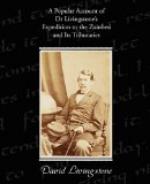CHAPTER XII.
Return to the Zambesi—Bishop Mackenzie’s grave—Frightful scenes with crocodiles—Death of Mr. Thornton—African poisons—Recall of the Expedition.
We put to sea on the 18th of October, and, again touching at Johanna, obtained a crew of Johanna men and some oxen, and sailed for the Zambesi; but our fuel failing before we reached it, and the wind being contrary, we ran into Quillimane for wood.
Quillimane must have been built solely for the sake of carrying on the slave-trade, for no man in his senses would ever have dreamed of placing a village on such a low, muddy, fever-haunted, and mosquito-swarming site, had it not been for the facilities it afforded for slaving. The bar may at springs and floods be easily crossed by sailing-vessels, but, being far from the land, it is always dangerous for boats. Slaves, under the name of “free emigrants,” have gone by thousands from Quillimane, during the last six years, to the ports a little to the south, particularly to Massangano. Some excellent brick-houses still stand in the place, and the owners are generous and hospitable: among them our good friend, Colonel Nunez. His disinterested kindness to us and to all our countrymen can never be forgotten. He is a noble example of what energy and uprightness may accomplish even here. He came out as a cabin-boy, and, without a single friend to help him, he has persevered in an honourable course until he is the richest man on the East Coast. When Dr. Livingstone came down the Zambesi in 1856, Colonel Nunez was the chief of the only four honourable, trustworthy men in the country. But while he has risen a whole herd has sunk, making loud lamentations, through puffs of cigar-smoke, over negro laziness; they might add, their own.
All agricultural enterprise is virtually discouraged by Quillimane Government. A man must purchase a permit from the Governor, when he wishes to visit his country farm; and this tax, in a country where labour is unpopular, causes the farms to be almost entirely left in the hands of a head slave, who makes returns to his master as interest or honesty prompts him. A passport must also be bought whenever a man wishes to go up the river to Mazaro, Senna, or Tette, or even to reside for a month at Quillimane. With a soil and a climate well suited for the growth of the cane, abundance of slave labour, and water communication to any market in the world, they have never made their own sugar. All they use is imported from Bombay. “The people of Quillimane have no enterprise,” said a young European Portuguese, “they do nothing, and are always wasting their time in suffering, or in recovering from fever.”




